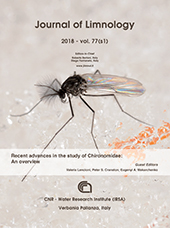Original Articles
13 June 2018
Vol. 77 No. s1 (2018): Recent advances in the study of Chironomidae: An overview
Are there so many congeneric species of chironomid larvae in a small stream?
Co-occurrence of congeneric species of chironomid larvae

Publisher's note
All claims expressed in this article are solely those of the authors and do not necessarily represent those of their affiliated organizations, or those of the publisher, the editors and the reviewers. Any product that may be evaluated in this article or claim that may be made by its manufacturer is not guaranteed or endorsed by the publisher.
All claims expressed in this article are solely those of the authors and do not necessarily represent those of their affiliated organizations, or those of the publisher, the editors and the reviewers. Any product that may be evaluated in this article or claim that may be made by its manufacturer is not guaranteed or endorsed by the publisher.
1160
Views
695
Downloads






